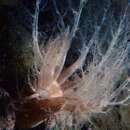Psolus phantapus: Brief Summary
provided by wikipedia EN
Psolus phantapus, also known as the brown psolus, is a species of sea cucumber in the family Psolidae.
- license
- cc-by-sa-3.0
- copyright
- Wikipedia authors and editors
Breeding
provided by World Register of Marine Species
Non-feeding barrel-shaped red larva. February - March
Distribution
provided by World Register of Marine Species
Gulf of St. Lawrence (unspecified region), Saguenay Fjord, northern Gaspe waters, lower St. Lawrence estuary, Magdalen Islands (from eastern Bradelle valley to the west, as far as Cape North, including the Cape Breton Channel), Prince Edward Island (from the northern tip of Miscou Island, N.B. to Cape Breton Island south of Cheticamp, including the Northumberland Strait and Georges Bay to the Canso Strait causeway), middle North Shore (from Sept- Iles to Cape Whittle, including the Mingan Islands); western slope of Newfoundland, including the southern part of the Strait of Belle Isle but excluding the upper 50m in the area southwest of Newfoundland; Cobscook Bay
North-West Atlantic Ocean species (NWARMS)
- license
- cc-by-4.0
- copyright
- WoRMS Editorial Board
Distribution
provided by World Register of Marine Species
In depths of 10 to more than 200 m; small animals llive on stones, like P. squamatus, larger ones live partly buried in muddy gravel. Occurs rather sporadically and seasonally around the British Isles, from the Celtic Sea to the Clyde sea lochs, Shetland and the North Sea.
Habitat
provided by World Register of Marine Species
intertidal, infralittoral and circalittoral of the Gulf and estuary
North-West Atlantic Ocean species (NWARMS)
- license
- cc-by-4.0
- copyright
- WoRMS Editorial Board

